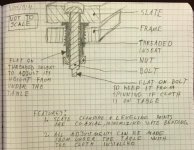As far as your comment of experience, you are correct I have none in designing or even assembling pool tables. That said, it is often a very good idea when brainstorming, to get people who have zero experience with the product of discussion to take a look at it. They might come up with an idea that the people with decades of experience don't see, often due to tunnel vision. This type of strategy is used every day in companies that design products. I brainstorm a lot in my day job, with teams of people. We always say there is no bad idea. And even if you think an idea might not work, to sketch it out anyway. It might cause another person to have an ah-ha moment and come up with something else that may eventually work.
Don't get me wrong, I fully understand the concept of your idea, but sir, what you completely fail to understand is this industry, and the manufacturers involved within it. What makes you believe any manufacturer in this industry would be open to the idea of spending $$$ to have new slates drilled to accommodate a leveling system for the slates, when so very few even care about any sort of system, to them, wedges work just fine. Besides that, the cost of installing a leveling system at the bottom of the feet for 95% of the home tables sold today would run less than $10 per table, I know, I install the levelers myself when ever I work on a home table....just to make the job of leveling the frame of the table easier for myself.
You use words like , COULD, HYPOTHETICALLY, I'D GUESS, I WOULD BELIEVE, PROBABLY LESS WOULD BE NEEDED, ENVISIONING. What you really fail to understand, is that the old saying, "if it ain't broke, don't fix it" rings loud in this industry. One other thing you completely fail to understand is that the greatest source of knowledge on to improve the pool tables being built today, as well as all those that have come before them, comes from all those that have to work on "cabinet maker" or "design engineers" who do NOT have to work on, or follow up on the products they have designed, been produced, and sold! This is truly an uneducated industry full of misfits making a living calling themselves "pool table mechanic's" when in the truth of the matter, there are in fact very few that really know what they're doing working on setting pool tables up, installing the cloth right, and leveling pool table correctly.
Here's the problem with any kind of leveling systems already in use today, 99% of the people working on pool tables don't know how to use what's already available to be used. Diamond has one of the simplest leveling systems on the market today, and gets flooded with calls from people that don't know how to use it.
I have an even simpler system, which I might add, works 100%, so I don't need to improvement, it just needed to be taught.
In the words of Mark Gregory, and myself I might add, it's the job of a true pool table mechanic to fix, repair, change, or otherwise modify the pool table currently being worked on from all those that have worked on it before us, or what the manufacturer should have designed better in the first place, or at least along the way.
One other thing you fail to understand because you are not familiar with this industry, is the fact that almost no 2 pool table manufacturers share the same table frame design, so basically there's as many different pool table frames as there is car manufacturer's, therefore no one system fits all.
Here's one more point of view, if the table manufacturing industry truly wanted to build better pool tables today, they'd seek out the advice of the most knowledgeable pool table mechanic's today, and ask them for their advice on how to improve their products, but that hasn't happened as of yet, not since John Brunswick started building his first pool table, the closest to that request came from Diamond to me to help in the design of their coin operated pool tables....because I had background knowledge of not only how every coin op pool table had been built, but that I had already designed, built, and sold 128 of my own coin operated pool tables, which were unlike any other tables built at the time.
So, my only advice to you would be, you should really know something about the industry you feel you could help improve with new ideas.....first, before you consider some of your ideas for improvement....I'm just throwing my opinion out there, do with it as you like:grin:

